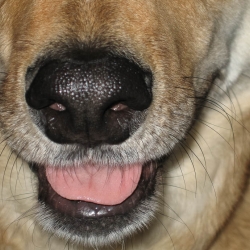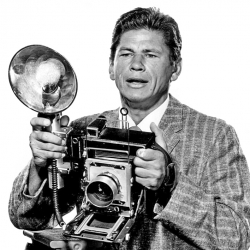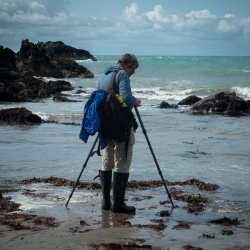Home > Topics > Equipment & Techniques > Medium Format > Tilt-shift sensor? Variable ISO sensor?
Tilt-shift sensor? Variable ISO sensor?
Tagged: Uniform Light Tool
-
AuthorTopic: Tilt-shift sensor? Variable ISO sensor? Read 1319 Times
-
Medium Formaton: July 18, 2019 at 11:30 am
OK, I’m not a tech person. But I’m thinking here. If cameras can do pixel shift for high resolution capture, and do yaw and pitch adjustments for image stabilization, it seems at least possible to expand this kind of movement to include traditional tilt-shift type movements. I wonder if in the blue-sky thinking out there, someone is thinking about making a system with lenses that have huge image circles, and the sensor able to be tilt-shifted by the photographer?
On another blue-sky wish, and I realize that this would seem to be really complex, what if the sensor / processor could vary the ISO on a pixel by pixel basis so that shadows get more exposure, highlights less, etc., for expanded DR in a single shot?
And just for fun (acknowledging that my ideas may be complete lunacy technically or practically) what other blue-sky stuff have you all thought about that we may see, or wish we might see, in the future.
Some things seem easily implementable, but just ignored by manufacturers like a raw histogram? What’s up with that, anyway?
Rand
Rand Scott Adams Rand47
Re: Tilt-shift sensor? Variable ISO sensor?Reply #1 on: July 19, 2019 at 5:29 amThe tilt shift is interesting. It would be difficult to figure out how to use tilt effectively because that is tilting the “rear standard.” For the “normal” use of tilt you want to tilt the lens. You could go through some process to transfer that tilt to the lens by tilting the camera forward, but it would not be quite the same. It is tough for me to imagine how that process would work without being too cumbersome.
Shift and rise/fall could be more useful. That would take some real estate for a useable range; possible though.
As for other blue-sky stuff, I always wondered why a pixel can not detect wavelength directly along with number of photons. I think different wavelengths have different focus points through the lens, along with different energy.
Dave
How glorious a greeting the sun gives the mountains! - John Muir
https://www.davechewphotography.com
Find legacy Schneider-Kreuznach Apo-Digitar lens data here: https://www.davechewphotography.com/skdata/Re: Tilt-shift sensor? Variable ISO sensor?Reply #2 on: August 12, 2019 at 12:48 pmI think the challenge would be how much the sensor would need to move to accomplish tilt shift. For current stability the sensors are moving microns. I think it would take quite a bit more room and sensor movement to accomplish tilt.
Probably possible, but perhaps not practical, and maybe not market viable.
Re: Tilt-shift sensor? Variable ISO sensor?Reply #3 on: August 27, 2019 at 6:42 pmThe tilt shift is interesting. It would be difficult to figure out how to use tilt effectively because that is tilting the “rear standard.” For the “normal” use of tilt you want to tilt the lens. You could go through some process to transfer that tilt to the lens by tilting the camera forward, but it would not be quite the same. It is tough for me to imagine how that process would work without being too cumbersome.
Shift and rise/fall could be more useful. That would take some real estate for a useable range; possible though.
As for other blue-sky stuff, I always wondered why a pixel can not detect wavelength directly along with number of photons. I think different wavelengths have different focus points through the lens, along with different energy.
Dave
Take a good look at Ansel Adams images like Mt. Williamson. Many others used the same technique. A bit longer than normal lens and rear tilt to get the foreground “looming” for stronger composition.
A tilt, shift back sounds nice but without the ability to shift either the front of rear standard you are crippling it. A shortfall of many small format tilt/shift lenses. Swings, tilts and sift? A View Camera with adapter for the digital body would work and most likely cost a lot less than a quickly outdated purpose built digital one.
"A good still photograph, studied by an inquiring mind, frequently yields more information than a mile of moving images". Walter Cronkite, New York, June 1989
Re: Tilt-shift sensor? Variable ISO sensor?Reply #4 on: August 28, 2019 at 5:45 amTake a good look at Ansel Adams images like Mt. Williamson. Many others used the same technique. A bit longer than normal lens and rear tilt to get the foreground “looming” for stronger composition.
A tilt, shift back sounds nice but without the ability to shift either the front of rear standard you are crippling it. A shortfall of many small format tilt/shift lenses. Swings, tilts and sift? A View Camera with adapter for the digital body would work and most likely cost a lot less than a quickly outdated purpose built digital one.
Yeah, agree with all that. His Tetons-fence image also comes to mind. In fact, in his book, “The Camera,” he states back tilt being his preferred method in cases like you described. I have a second tilt adapter on the way so I can tilt-swing both the lens and/or back at the same time (at least for normal to longer lenses). With only one adapter, I can tilt-swing either back or lens, but not both at the same time.
It’s just that for the application stated here, which I interpreted as a way to mimic a tilt-shift lens, it would be a different result users would not be familiar with. And, if ever used when the photographer wants the sensor to be oriented to the subject, that would be difficult to set up. At least in my head!
Dave
How glorious a greeting the sun gives the mountains! - John Muir
https://www.davechewphotography.com
Find legacy Schneider-Kreuznach Apo-Digitar lens data here: https://www.davechewphotography.com/skdata/Re: Tilt-shift sensor? Variable ISO sensor?Reply #5 on: August 28, 2019 at 9:08 amTilt and Shift with sensors has been a problem for a long time. The issue is the sensor well and microlenses on top of sensors want light coming through the read element of the lens in a straight direction. Introduce tilt and the light now comes in sideways to the sensors and the lens on the sensor and not all light hits the bottom of the sensor well, This cause a color shift usually magenta and green. Phase One has been combatting this for years with a special software app. After you expose the image where you are using swings and tilts, you take a second exposure with a diffuser in front of the lens. You set the exposure for this so the histogram is right in the middle. The file will be an ugly looking gray file with odd colors. Phase One’s software reads this file and figures out how to make it uniform all the way across and then saves the file. You then apply this correction file to the original file and it gets cleaned up like magic. I suppose that same thing can be done with any image with tilt and shifts on other sensors. It’s actually pretty cool to see in action. It’s, part of the Capture One Pro software.
Kevin Raber
Owner and Publisher of photoPXLRe: Tilt-shift sensor? Variable ISO sensor?Reply #6 on: August 28, 2019 at 11:44 amEven if Kevin’s point about microleneses can be overcome with a second diffused exposure to cancel out the colour casts we are left with the problem of scaling up the up/down movement from the present 1-2mm to 10+mm and every lens having an image circle appreciably larger than is presently the case, oh and before I forget the lens throat diameter may have to be even larger than the new Nikon Z. The IBIS system looks as though it doesn’t move in a front/back direction and for tilt to work this would need to be implemented, this on first thoughts would seem incredibly difficult ie a sensor that has to float in 3D with the ability to move 10mm in any direction but not move at all when needed unless it senses vibration. Of course it would also allow you to stitch very large images together with minimum optical distortion, if you are interested in this I note that RhinoCam will allow you to use your present camera as a tilt camera to overcome converging verticals and also produce large stitched panoramas. However I am not a mechanical engineer and it may be possible to float a sensor with this amount of freedombut the resultant camera would be large. If you ignore the IBIS and shifting the sensor and just have lenses with large image circles and a large sensor that doesn’t need to be moved you have a phase one camera, all you need to do is throw away the part of the image that you don’t want and are left with say 75Mp at the top, surely enough, even for instagram, and you get a RAW histogram. Ken
Re: Tilt-shift sensor? Variable ISO sensor?Reply #7 on: December 5, 2019 at 10:36 amI wanted to pop in here and thank you all for the thoughtful replies to my original post. A great learning experience for me. Thanks one and all.
Rand
Rand Scott Adams Rand47
-
AuthorPosts
- You must be logged in to reply to this topic.






